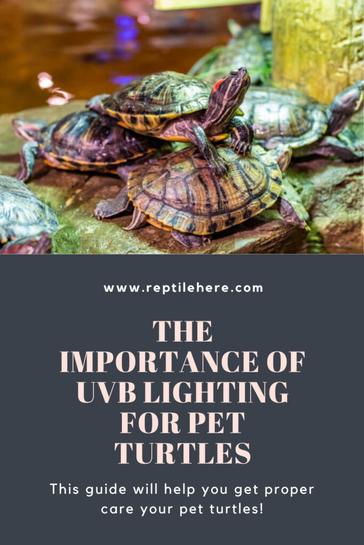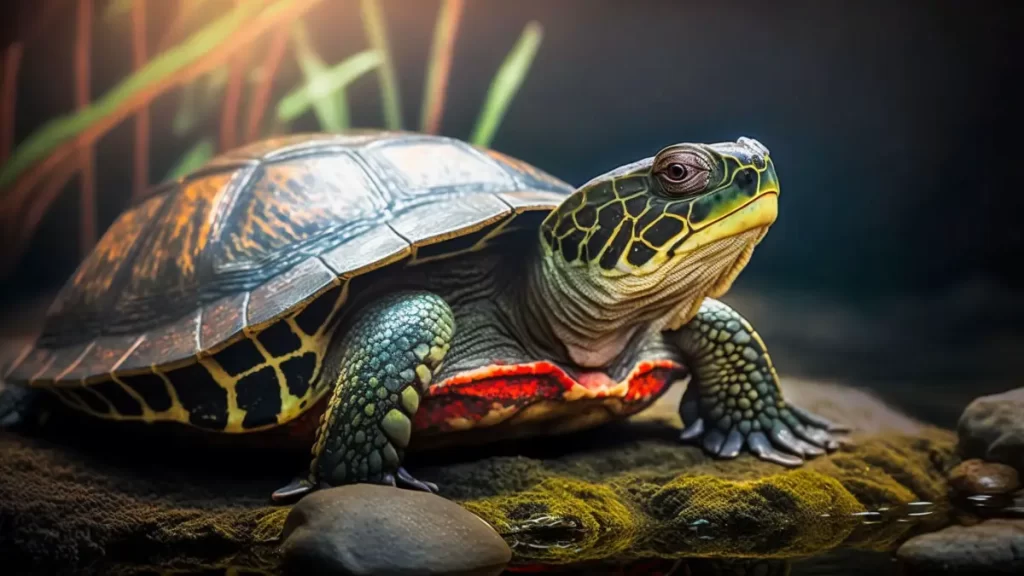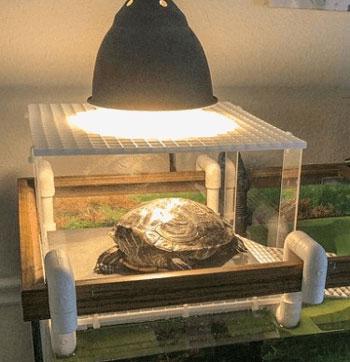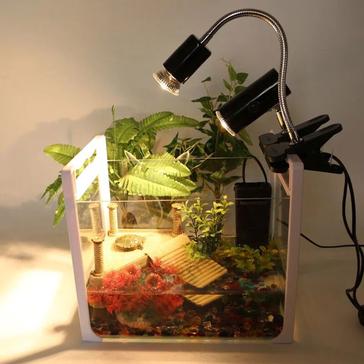Do you know how important UVB lighting is for your turtle’s health? It may not be something you think about often, but providing your turtle with access to UVB rays can have significant benefits for their overall well-being. In this article, we will explore the importance of UVB lighting for turtles and how it can positively impact their health. So, if you’re curious to learn more about this topic, keep on reading!
UVB lighting plays a crucial role in the health of turtles, just like sunlight does for humans. It helps turtles synthesize vitamin D3, which is essential for calcium absorption and bone development. Without adequate levels of UVB radiation, turtles can develop serious health issues, such as metabolic bone disease and shell deformities. By providing UVB lighting for your turtle, you are essentially simulating the natural sunlight they would receive in the wild, allowing them to maintain optimal health. In our upcoming article, we will dive deeper into the specific benefits of UVB lighting and provide you with tips on how to choose the best lighting setup for your turtle’s enclosure. So, stay tuned and get ready to enhance your turtle’s well-being!

Importance of UVB Lighting for Turtles
Turtles are fascinating creatures that make for unique and rewarding pets. However, as with any animal, their health and well-being should be a top concern for any turtle owner. One crucial aspect of turtle care that is often overlooked is the importance of UVB lighting. UVB lighting plays a pivotal role in a turtle’s overall health, and understanding its benefits is essential for providing optimal care.
Role of UVB Lighting in Turtle’s Health
In the wild, turtles bask in the sunlight, exposing themselves to both UVA and UVB rays. These rays are crucial for various physiological processes within their bodies. UVA rays help regulate their daily activity patterns and aid in vision, while UVB rays play a more significant role in their health.
UVB Lighting and Calcium Metabolism
One of the primary benefits of UVB lighting for turtles is its influence on calcium metabolism. As ectothermic animals, turtles rely on external sources of heat to regulate their body temperature. This dependency extends to the metabolism of calcium, a vital mineral required for healthy shell and bone development.
UVB rays stimulate the production of vitamin D3 in the turtle’s skin. This synthesized vitamin D3 then aids in the absorption and utilization of dietary calcium. Without adequate levels of vitamin D3, turtles may suffer from calcium deficiency, leading to weak shells, deformed bones, and an increased risk of developing metabolic bone disease (MBD).
UVB Lighting and Vitamin D3 Synthesis
Vitamin D3 is essential for calcium absorption, promoting healthy bone growth and preventing skeletal deformities in turtles. While vitamin D3 can also be obtained through specific dietary sources, UVB lighting offers a more natural and efficient means of vitamin D3 synthesis.
When turtles are exposed to UVB rays, their skin converts a precursor molecule into active vitamin D3. This active form is then circulated throughout their bodies, enabling proper calcium metabolism and supporting overall bone health. Without access to UVB lighting, turtles may become deficient in vitamin D3, leading to a range of health issues.
Promotes Shell and Bone Health
Stronger Shell Development
Proper shell development is crucial for a turtle’s protection and overall well-being. UVB lighting plays a fundamental role in ensuring strong and healthy shells. When turtles receive adequate UVB exposure, their shells develop the necessary strength and density to withstand external pressures and potential injuries.
Additionally, UVB lighting aids in maintaining the structural integrity of the shell. It promotes the growth of healthy keratinocytes, the cells responsible for forming the outer layer of the shell. This process ensures that the shell remains tough and resilient throughout the turtle’s life.
Prevention of Metabolic Bone Disease
Metabolic bone disease (MBD) is a prevalent condition among turtles and other reptiles kept in captivity. It occurs when turtles are unable to obtain sufficient calcium and vitamin D3, leading to weakened bones and a range of related health issues.
By providing your turtle with appropriate UVB lighting, you can effectively prevent the development of MBD. The UVB rays stimulate the production of vitamin D3, allowing for the proper absorption and utilization of calcium. This, in turn, helps maintain strong bones and reduces the risk of MBD.

Enhances Immune System
UVB Lighting and Vitamin Production
UVB lighting not only supports the synthesis of vitamin D3 but also enhances the production of other essential vitamins within a turtle’s body. These vitamins play a crucial role in maintaining a strong immune system, protecting the turtle from various illnesses and infections.
When turtles receive adequate UVB exposure, their bodies can produce vitamin A, which is necessary for healthy skin and mucous membranes. Vitamin A also contributes to proper vision and immune function. Additionally, UVB rays help stimulate the production of vitamin E, which acts as a powerful antioxidant, protecting the turtle’s cells from damage.
Better Disease Resistance
A robust immune system is vital for a turtle’s ability to fight off diseases and infections. UVB lighting plays a significant role in enhancing the turtle’s natural immune response, making them less susceptible to various illnesses.
When turtles receive appropriate UVB exposure, their immune cells become more active and efficient, providing better protection against harmful pathogens. This increased immune response can significantly reduce the risk of infections and improve the overall health and longevity of your turtle.
Supports Essential Functions
Regulation of Circadian Rhythm
Turtles, like many reptiles, rely on external cues to regulate their daily activity patterns. One such cue is the natural rhythm of light and darkness. UVB lighting helps replicate the natural sunlight conditions that turtles experience in the wild, allowing them to maintain a healthy circadian rhythm.
By providing your turtle with a proper light cycle, including a consistent UVB source, you ensure that their internal clock remains synchronized. This promotes regular periods of activity and rest, contributing to their overall well-being and quality of life.
Stimulation of Appetite and Activity
Proper exposure to UVB lighting also has a direct impact on a turtle’s appetite and overall activity levels. Turtles who receive adequate UVB exposure are more likely to exhibit healthy eating habits and engage in regular physical activity.
UVB rays stimulate the production of serotonin, a neurotransmitter that plays a role in regulating mood, appetite, and activity levels. Turtles exposed to UVB lighting enjoy a boost in serotonin levels, leading to increased appetite and energy. This can help ensure that your turtle maintains a healthy weight and remains active and engaged in their environment.

Prevents Eye and Skin Issues
Reduced Risk of Eye Infections
Turtles are prone to developing various eye conditions, including bacterial and fungal infections. UVB lighting can significantly reduce the risk of these infections by providing the necessary UV rays that help maintain healthy eyes.
UVB rays help stimulate the production of tears in turtles, which act as a natural defense against pathogens. Tears help flush out potential irritants and prevent the buildup of harmful bacteria on the surface of the eyes. By providing your turtle with appropriate UVB lighting, you can help keep their eyes healthy and minimize the risk of infections.
Prevention of Shell Rot
Shell rot is a common condition among turtles, characterized by the deterioration of the shell’s outer layer. It is commonly caused by a combination of factors, including poor water quality, inadequate diet, and lack of UVB exposure.
UVB lighting plays a crucial role in preventing shell rot by promoting healthy, resilient shells. The UVB rays stimulate the growth of beneficial bacteria on the turtle’s shell, which help prevent the overgrowth of harmful pathogens. Additionally, UVB rays help keep the shell dry and free from excessive moisture, reducing the risk of fungal infections.
Choosing the Right UVB Lighting
UV Index and Intensity Requirements
When selecting UVB lighting for your turtle, it is essential to consider the UV index and intensity requirements specific to their species. Different species of turtles have varying UVB needs, and it is crucial to provide the appropriate level of UVB radiation.
UVB bulbs are rated based on their UV index output, ranging from 0.1 to 10+. Researching and understanding the specific UV index requirements for your turtle species will help determine the appropriate UVB bulb to purchase.
Ideal Light Spectrum for Turtles
In addition to UVB radiation, turtles also benefit from exposure to UVA and visible light. UVA rays contribute to their overall well-being, while visible light aids in their color perception and vision.
When choosing UVB lighting for your turtle, ensure that the bulb also emits UVA and visible light in the appropriate spectrum. This will provide a more natural and complete lighting environment for your turtle, mimicking the conditions they would experience in the wild.

Proper Placement and Duration
Optimal Distance from the Basking Area
To provide your turtle with the maximum benefits of UVB lighting, it is crucial to position the bulb at the correct distance from their basking area. The optimal distance will vary depending on the intensity and type of UVB bulb you are using.
Research the specific recommendations for your turtle species to determine the ideal distance for UVB exposure. Generally, a distance of 8 to 12 inches from the basking area is a good starting point. However, it is essential to monitor your turtle’s behavior and adjust the placement accordingly to ensure they are receiving adequate UVB exposure without overheating.
Recommended Daily Exposure Time
Turtles require regular exposure to UVB lighting to maintain their health. The recommended daily exposure time will vary depending on the species, age, and natural habitat of your turtle.
In general, most turtle species require a daily exposure of 10 to 12 hours of UVB lighting. However, some species may need more or less, so it is vital to research the specific needs of your turtle to ensure they are receiving the appropriate amount of UVB radiation.
Avoiding Overexposure to UVB
Signs of UVB Overexposure
While UVB lighting is essential for a turtle’s health, overexposure can also pose potential risks. It is crucial to be aware of the signs of UVB overexposure to prevent any adverse effects on your turtle.
Signs of UVB overexposure in turtles may include lethargy, reduced appetite, red or swollen eyes, shell discoloration, and skin burns. If you notice any of these symptoms, it is essential to adjust the intensity, placement, or duration of UVB exposure to ensure your turtle’s well-being.
Potential Health Risks
Overexposure to UVB radiation can lead to various health issues in turtles. Prolonged or excessive exposure to UVB rays can cause eye damage, skin burns, shell rot, shell softness, and even UV radiation poisoning.
To avoid these potential risks, it is crucial to provide your turtle with the appropriate amount and intensity of UVB radiation. Following the recommended guidelines for placement, duration, and maintaining a proper distance from the basking area will help ensure your turtle receives the benefits of UVB lighting without any adverse effects.

UVB Lighting Options
Fluorescent Tube Lights
Fluorescent tube lights are a popular choice for providing UVB lighting to turtles. They are available in various sizes and UV index outputs, making it easier to find the right level of UVB radiation for your turtle species.
When using fluorescent tube lights, it is important to choose a bulb specifically designed for reptiles. These bulbs emit both UVB and UVA rays and provide a more natural lighting environment for your turtle.
Mercury Vapor Bulbs
Mercury vapor bulbs are another option for providing both UVB and UVA radiation to your turtle. These bulbs are more powerful and emit higher levels of UVB rays compared to fluorescent tube lights.
Mercury vapor bulbs are recommended for larger enclosures and species that require higher levels of UVB radiation. However, they may generate more heat, so it is crucial to monitor the temperature in the basking area to prevent overheating.
Compact UVB Lights
Compact UVB lights, also known as coil bulbs or compact fluorescent lamps (CFLs), are a compact and energy-efficient option for UVB lighting. These bulbs emit both UVB and UVA rays and are available in various UV index outputs.
While compact UVB lights offer convenience and energy efficiency, it is important to consider that their intensity may decrease over time. Regular bulb replacement and monitoring of UV radiation levels are necessary to ensure your turtle continues to receive adequate UVB exposure.
Maintenance and Replacement
Regular Cleaning and Inspection
To maximize the benefits of UVB lighting, regular cleaning and inspection of the bulbs and fixtures are essential. Dust and dirt can accumulate on the surface of the bulb, reducing its UV radiation output over time.
Periodically cleaning the bulb with a soft cloth or a UVB-specific bulb cleaning product will help maintain its effectiveness. Additionally, inspecting the fixture for any damages or loose connections will ensure safe and optimal UVB lighting for your turtle.
Timely Bulb Replacement
UVB bulbs, regardless of the type, have a limited lifespan. Over time, their UV output decreases, making it essential to replace them regularly to maintain their effectiveness.
Research the specific recommendations for the UVB bulb you are using to determine the recommended replacement interval. In general, UVB bulbs should be replaced every 6 to 12 months to ensure your turtle continues to receive adequate UVB radiation.
Other Considerations
Temperature and Humidity Control
In addition to UVB lighting, maintaining appropriate temperature and humidity levels is crucial for a turtle’s health. Different species of turtles have specific temperature and humidity requirements, and it is essential to provide them with a suitable environment.
Research the specific temperature and humidity needs for your turtle species to ensure they are thriving in their enclosure. Combining proper UVB lighting with adequate temperature and humidity control will create an optimal environment for your turtle’s overall well-being.
Adequate Filtration and Water Quality
Turtles rely on clean and properly filtered water for their overall health and well-being. Poor water quality can lead to various health issues, including skin and shell infections.
Investing in a high-quality filtration system and regularly monitoring the water parameters will help ensure your turtle’s optimal health. Additionally, providing your turtle with a proper basking area and dry resting spots will allow them to dry off and prevent prolonged exposure to moisture, reducing the risk of shell and skin problems.
Common Myths about UVB Lighting
Turtles Don’t Need UVB Lighting
One common myth surrounding turtle care is that they do not require UVB lighting. This misconception can seriously impact their health and well-being.
Turtles, just like other reptiles, have evolved to rely on UVB radiation for essential physiological functions, including calcium metabolism, vitamin production, and immune system support. Without access to UVB lighting, turtles are at risk of developing various health issues, including metabolic bone disease, eye infections, and weakened immune systems.
Indoor Lighting Can Substitute Natural UVB
Another common misconception is that the UVB radiation provided by indoor lighting is sufficient for turtles’ needs. While certain types of artificial lighting may emit UVB rays, they are usually not at the appropriate intensity or spectrum to effectively meet a turtle’s UVB requirements.
Natural sunlight is the best source of UVB radiation for turtles. However, when natural sunlight is not readily available, providing your turtle with a UVB-specific bulb is necessary to ensure they receive the necessary UVB exposure for their health.
Monitoring Turtle’s Health and Behavior
Observing Feeding Habits and Vitality
Regularly monitoring your turtle’s feeding habits and vitality is crucial for assessing their overall health. Changes in appetite, lethargy, or unusual behaviors may be indicators of underlying health issues.
A turtle that receives adequate UVB exposure should display healthy appetite levels, actively engage with its environment, and exhibit an overall vitality. If you notice any significant changes in their feeding habits or behavior, it is essential to consult with a veterinarian to rule out any potential health concerns.
Veterinarian Check-ups
Regular veterinary check-ups are an essential part of maintaining your turtle’s health. A reptile veterinarian experienced in turtle care will be able to provide a comprehensive health examination and address any concerns or potential issues.
During the check-up, the veterinarian will assess the turtle’s shell and skin condition, evaluate their overall body condition, and provide guidance on UVB lighting and other essential aspects of turtle care. Routine veterinary care ensures that any health issues are caught early and treated effectively, contributing to the longevity and well-being of your turtle.
Conclusion
UVB lighting is a crucial aspect of caring for your turtle. Its benefits, including promoting shell and bone health, enhancing the immune system, supporting essential functions, and preventing eye and skin issues, cannot be overstated. By investing in quality UVB lighting and providing the appropriate level of exposure, you ensure that your turtle thrives and remains healthy throughout their life.
Remember to choose the right UVB lighting for your turtle’s species, closely monitor their behavior and health, and consult with a reptile veterinarian for any concerns. By prioritizing UVB lighting and providing your turtle with the optimal conditions they need, you are ensuring their well-being and enriching their lives as cherished pets.